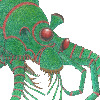HOME | DD
 Sheather888 — Birdwhales
Sheather888 — Birdwhales

Published: 2017-01-26 18:23:32 +0000 UTC; Views: 18152; Favourites: 257; Downloads: 0
Redirect to original
Description
The great blue blorca, which feeds on plankton in the cold northern and southern seas, is one of the largest filter-feeding birdwhales, just over fifty feet in length.~~~
Cetaforme pelecanaries, colloquially known as "birdwhales", are very large, entirely aquatic pelecanaries which occur in abundance across all of Serina's seas by the Cryocene. A group which includes the bloon, it's a highly diverse clade with representatives that fill many different niches, all tied together by their mouth-brooding behavior. By incubating their single large eggs in their throat pouches rather than on land, all birdwhales have cut their ties to the shore, freeing some to become the largest birds ever to live.
Whereas the basal bloon is an herbivore, most birdwhales are predatory and eat either fish, plankton, or other aquatic invertebrates. Forms are specialized as pursuit hunters, bottom-feeders, and filter-feeders, the latter being among the most specialized. Birdwhales use large paddle-shaped wings to swim through the water, sometimes also using their hind legs to assist while in other groups the hind limbs are fused into a rudder-like tail. They are almost totally featherless with smooth skin and keep warm with insulating layers of body fat. Fish-eating birdwhales often exhibit large pseudotheeth in their bills to hold onto their prey, while planktonivores have wide-gaping mouths and gigantic throat pouches to scoop up huge mouthfuls of seawater. While taking in food, the tongue is lifted to the roof of the mouth, blocking water from going down the throat into the stomach or airways. The tongue is then brought down and the water is strained out of the mouth through hair-like cillia which have formed on its edges, producing a seining net that catches any small fish or invertebrates which are then consumed. Some filter feeders specialize on small fish while others target Serinan "krill" - any variety of free-swimming crustaceans, from copepods and shrimp to crab larvae. Some birdwhales feed by filtering the sediment on the sea floor. While most filter-feeding birdwhales are very large animals, they are not on the whole as large as the biggest whales on Earth. The very longest birdwhale species, in fact, is not a filter feeder at all - it is the bloon, a vegetarian of coastal waters.
Filter-feeders are most abundant in the cold polar seas near Serina's poles, where the waters are rich in nutrients. The calves are born large and able to swim and feed themselves at birth, but require their parents' guidance to find food and avoid predators; they stay with their parents for many years before becoming independent. Birdwhales mate for life, almost always being found in pairs at the minimum, with some species living in large extended families. If lucky, the largest birdwhales can live for more than two hundred years.
Related content
Comments: 9

👍: 0 ⏩: 0

I like this concept
I can make the tree whale
reizosaurus-64.deviantart.com/…
👍: 0 ⏩: 0

It looks even more whale-like compared to the Vortex (a giant future penguin) from Dougal Dixon's After Man: A Zoology of the Future and the Gannetwhales from the 2002 documentary mini-series, The Future is Wild.
👍: 1 ⏩: 0

Great idea, I like how the tongue is used as a filtering mechanism.
👍: 0 ⏩: 0

Pretty damn cool, though what happened to the mammals in this world?
👍: 0 ⏩: 1

It's a terraformed world, the only tetrapod introduced was a single species of canary.
👍: 0 ⏩: 1

It is really interesting how often we completelly independently create very simillar species 
👍: 0 ⏩: 0



















